IDEX Online Research: August Jewelry Sales Confirm Improving Trends
October 19, 09
“Cautious optimism” seems to be creeping back into jewelers’ vocabulary, and industry sales numbers back up their brightened outlook. August jewelry sales were “less bad” than some months earlier this year. Further, the U.S. Department of Commerce issued revised numbers that showed previous months’ preliminary jewelry sales trends were too pessimistic.
The following is a summary of August jewelry and watch sales (August 2009 versus August 2008):
All Jewelry & Watch Sales (6.6 percent) (All retail merchants who sell jewelry)
Jewelry (6.0 percent)
Watches (11.2 percent)
Specialty Jewelers’ Sales (10.6 percent) (Specialty jewelers only)
In addition to “less bad” jewelry sales in August, there are other positive indicators that suggest two very important trends: 1) the worst is clearly behind us in the current recessionary cycle; and 2) the recovery could come more quickly than some expect. Here are those positive – and hopeful – leading indicators:
- September preliminary numbers for retail sales and consumer spending were above analysts’ estimates. Further, the U.S. Department of Commerce revised previous months’ sales data upward – reflecting less onerous comparisons to last year.
- A poll shows that 80 percent of American economists think the recession is already over.
- The U.S. stock market is up. While the stock market is a poor leading indicator on the way down – it has predicted ten of the past five recessions – it is an excellent leading indicator of a strengthening economy.
- Many consumer goods producers and retailers are reporting sales and earnings above expectations.
- The U.S. personal savings rate has slipped, after rising sharply near the beginning of the current recession. As an economist, we view this as disappointing, but merchants welcome this injection of discretionary consumer cash.
Our current preliminary outlook for jewelry sales for the U.S. market, based on the current trends above and historic trends is as follows:
- November-December 2009 Holiday Selling Season
- Specialty Jewelers – 0 percent to +2 percent
- Total Jewelry Industry Sales – +2 percent to +4 percent
- Total Annual Jewelry Sales for 2009
- Specialty Jewelers – Down 6-8 percent
- Total Jewelry Industry sales – Down 3-4 percent
Unfortunately, we expect diamond jewelry sales to show unfavorable comparisons to these forecasts. It is likely that diamond jewelry sales will be down by low double-digit levels for the year – perhaps down by 10-13 percent, depending on the success of holiday sales marketing promotions. Further, gold jewelry is likely to show a disappointing sales comparison versus the industry average. However, other categories – colored stone jewelry, estate jewelry, custom jewelry, bridal jewelry, and others are expected to generate above-average sales comparisons – perhaps even year-over-year sales gains – for both the full year and the 2009 holiday selling season.
Monthly Jewelry Sales Trends
The following table summarizes monthly sales trends for specialty jewelers and total jewelry industry sales. We have included sales trends for 2007, 2008, and year-to-date 2009. It is clear that jewelry sales fell sharply in late 2008. Our forecast calls for 2009 sales in November and December to be above the previous year’s dismal levels, but still well below the level of 2007.
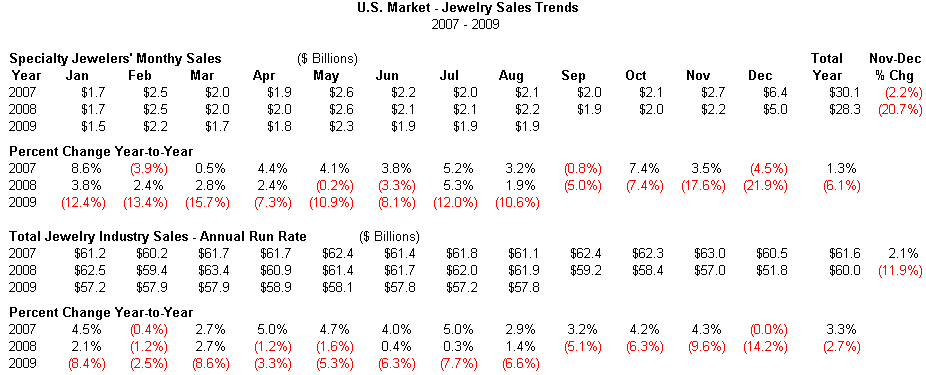 Source: US Dept of Commerce |
Unfortunately, jewelry sales continue to under-perform when compared to total retail sales trends in the U.S. As the table below illustrates, both specialty jewelers’ sales and total jewelry sales dipped deeper in August than total retail sales. However, in previous months, jewelry had performed slightly better. On average, jewelry sales are running at roughly the same rate – on a percentage change basis year-to-year – as total retail sales trends. Thus, the jewelry category apparently is not gaining or – more importantly – losing market share.
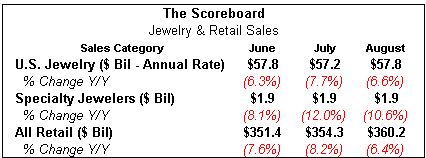
Source: US Dept of Commerce
Jewelry Retail Sales Trends Show Promise
Three key trends emerged from the Department of Commerce’s August retail sales report:
- After drifting in a downward trend for a couple of months, August jewelry sales reflected more positive comparisons, both for total industry sales as well as for specialty jewelers.
- Specialty jewelers continued to lose market share, a trend that has not only characterized the current recession, but is also a hallmark of previous recessions.
- The Commerce Department revised previous months’ numbers – back four months – to reflect that sales did not dip as far as initially reported.
The graph below contrasts specialty jewelers’ sales trends (red line) with total jewelry sales trends (blue line) for the past year.
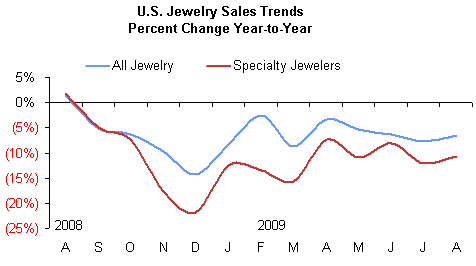
Source: US Dept of Commerce
Watch Demand Remains Relatively Weak
Three key trends emerged from retail sales data regarding jewelry versus watch demand:
- Jewelry demand is much stronger than watch demand.
- The disparity between watch demand and jewelry demand is widening.
- The Commerce Department revised previous months’ watch sales downward, reflecting a more unfavorable trend than previously reported.
As the graph below illustrates, August jewelry sales were down 6.0 percent from August 2008, while watch sales were down 11.2 percent.
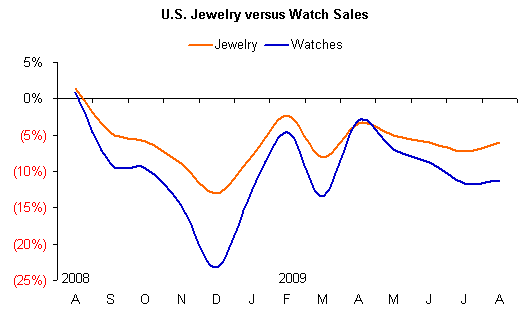 Source: US Dept of Commerce |
The LGI Network Time Tracker newsletter indicated that August same-store sales for watches were down about 18 percent. LGI tracks watches priced at $50 or more retail; thus, its universe is smaller than the Commerce Department’s universe of “all watches.” In today’s market, demand for lower-priced watches has not declined as greatly as for higher-priced watches; thus, we believe that demand for utility / commodity watches under $50 retail remains fairly solid.
The LGI Time Tracker also notes significant disparity in watch demand by retail price point:
- Sales of watches in the $50-$300 range (retail price) were down close to 20 percent in August.
- Watches priced $300 to about $5,000 were down 10 percent or less.
- Watches priced above $5,000 were down 20-30 percent, depending on the category.
Based on unit sales trends of watches, it appears that consumers are “shopping down.” That is, consumers who would normally purchase a very expensive watch are buying less expensive watches; this trend appears to be occurring at all price levels.
Specialty Jewelers’ Sales Trends Weaker Than Retail Sales Trends
Two key trends emerged from the Department of Commerce data regarding total retail sales versus jewelry industry sales in August.
- Specialty jewelers posted a sales decline of 10.6 percent, significantly below the total retail sales (ex-auto) decline of 8.1 percent. When automobile sales are included in August retail data, total retail sales declined by just 6.4 percent. Either way, specialty jewelers lost market share in August.
- The good news for specialty jewelers is that they participated in the retail sales rally in August. Preliminary retail sales figures for the U.S. market (all retail categories) suggest that September retail sales were even stronger. There is evidence that jewelers have been participants in the continuation of this sales rally in September.
The graph below summarizes sales trends for all retail goods (green line) excluding food and automobiles versus specialty jewelers’ sales (red line).
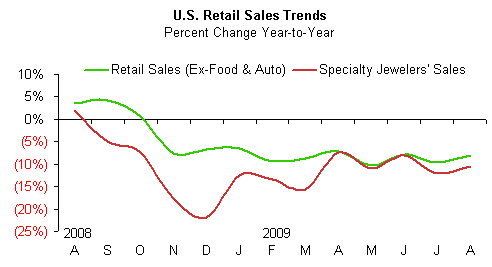 Source: US Dept of Commerce |
Jewelry Sales Dip Less Than Other Luxury Sales
In 2009, luxury retailer sales through August dropped by 16.3 percent, according to the International Council of Shopping Centers. In contrast, total jewelry sales were down less than 6 percent, and total watch sales dropped by about 9 percent. Specialty jewelers’ sales were off by just over 11 percent.
The graph below summarizes year-to-date through August sales performance for selected retail categories. The graph shows that consumers were willing to spend money at retailers who offered the perception of value. Sales at wholesale clubs were up 1.2 percent, while discounters’ sales were down less than 1 percent.
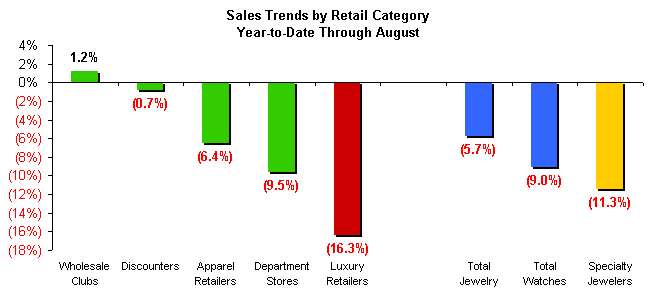 Source: US Dept of Commerce & ICSC |
The graph below summarizes estimated year-to-date sales by various key categories of jewelry. Diamonds represent about 50 percent of a jeweler’s sales; gold represents slightly less than 10 percent of sales. Categories such as colored gemstone jewelry, pearls, and other are showing smaller sales declines than the industry average.
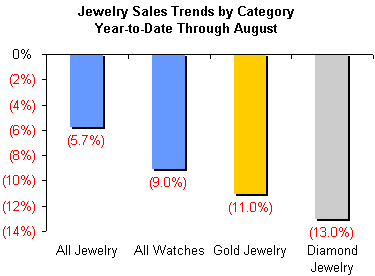 Source: IDEX Online Research |
August Consumer Spending Shows Notable Recovery
Data from the Department of Commerce and other sources shows the following trends for August consumer spending:
- After four consecutive months of declines in the 2 percent range, consumer spending (goods and services) showed a decline of only 0.3 percent (three-tenths of one percent) in August. This was welcome news. It also appears to confirm that Americans have returned to their old habits of saving less.
- Consumer spending, along with retail sales and jewelry sales, showed that consumers can continue to drive the American economy.
The graph below summarizes trends in American’s total spending (black line), retail sales of all goods (blue line) and expenditures on jewelry (red line). Dismal automobile sales in the U.S. market are having a dramatic negative impact on total retail sales (blue line). Automobile sales in 2007 (a “normalized” year) were just over 20 percent of total retail sales; thus, it is clear why they have such an impact on total retail sales trends. And, it should be obvious why we typically eliminate them, when we analyze U.S. retail sales: automobile sales are driven largely by the “deal-of-the-day,” as we noted above.
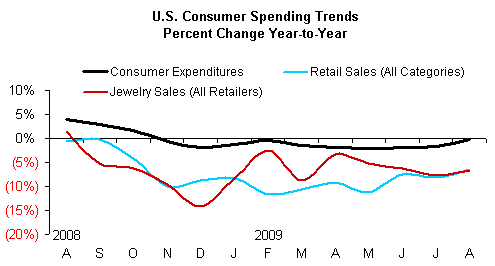 Source: US Dept of Commerce |
Jewelry Sales Forecasts Considers Headwinds & Tailwinds
While we can say with a reasonably high level of confidence that the worst of the current recessionary environment is behind us, there are still headwinds affecting jewelry demand and retailers’ sales. These headwinds include the following:
Headwinds
- Average jewelry ticket is down at retail.
- Lack of consumer credit availability has dampened jewelry sales.
- Conspicuous consumption appears to be out of favor; this has hurt luxury goods demand.
- Lack of new exciting jewelry has cut down on consumers’ frequency of shopping trips to local jewelers.
- Lack of an industry promotional focus has not helped keep jewelry a “top-of-mind” category. We had hoped that the planned consolidated promotional effort by diamond producers would be launched this year, but it has been put on hold.
- A focus on price by retail jewelers to exclusion of other factors hurts merchants’ credibility and detracts from the “luxury” image of jewelry.
There are also some tailwinds helping jewelers, including the following:
Tailwinds
- Consumer traffic has increased in U.S. malls.
- Jewelers and other retail merchants are reporting an increased number of transactions.
- Most merchants are reporting an increased conversion rate – browsers-to-buyers – in their stores.
- Bridal jewelry demand remains strong.
- Unique jewelry / fashion jewelry demand is solid.
- This year – especially during the holiday selling season – there is no hot consumer electronics gadget or other hot $200-500 ticket item vying for consumers’ discretionary dollars.
- Merchants who typically first emerge from a recession are reporting stronger consumer demand. For example, the sale of men’s suits is up, as men need those suits for job interviews, and, more importantly, for new jobs.
Our preliminary sales forecast for jewelry sales in 2009 is as follows:
Holiday Selling Season Jewelry Sales (November-December only)
- Specialty jewelers sales likely to be flattish to up about 2 percent in this year’s holiday selling season. This implies sales as high as $7.4 billion, up from last year’s $7.2 billion, but well below 2007’s $9.1 billion.
- Total jewelry sales likely to be up 2 percent to 4 percent in November-December 2009. This suggests that sales will be running at about $57 billion on an annual basis, up from last year’s roughly $54.5 billion run rate in November and December. This is well below 2007’s run rate of $61.7 billion in the holiday selling season.
Full Year Jewelry Sales
- Specialty jewelers are likely to post sales that are down 6 percent to 8 percent. This implies full year sales of $26.4 billion for specialty jewelers, down from 2008’s $28.3 billion. Two years ago – in 2007 – specialty jewelers posted record sales of $30.1 billion. Thus, the peak-to-valley sales decline for specialty jewelers will likely be about 12 percent in the current recession.
- Our current very tentative projections call for 2010 specialty jewelers’ sales to recover to as much as $28 billion, a gain of possibly 6 percent. In a recovery year, specialty jewelers’ sales often recover at the same rate as total jewelry industry sales grow (see projections for total industry below).
- Total jewelry sales are likely to be down 3 percent to 4 percent this year. This implies full year jewelry sales of about $57 billion, down from last year’s $60.0 billion. Total jewelry industry sales were a record $61.6 billion in 2007.
- Our current preliminary projections for total jewelry sales in 2010 indicate that sales could be in the $60.5 to $61.0 billion range, a 6 to 8 percent gain.
The graph below summarizes our longer term sales forecast for the U.S. jewelry industry. It assumes that the American economy will experience another slowdown around 2015 (recessionary periods are reasonably predictable – it is the stock market that is not nearly as predictable!). Further, we have been unable to assess the impact of faulty media reports about the economic situation. In our opinion the mass media’s dire economic reports – generally unwarranted – about the 2008-2009 recession helped deepen and prolong the current economic slump.
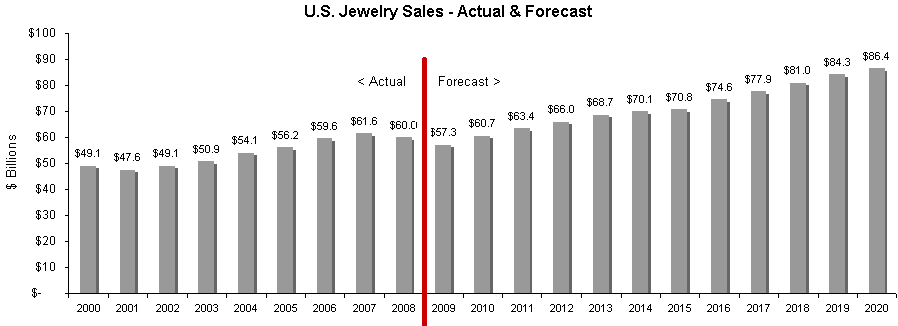
Source: US Dept of Commerce & IDEX Online Research
Information in this report from the LGI Time Tracker is courtesy of the LGI Network.